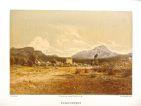
From Puigpuynent to Galilea
"The Puigpunyent path shares with the Valldemossa road the same exit from Palma. In a short while we leave it to the right to take a broad road heading in a straight line towards the Serra range.
The road continues a while along the small houses of Establiments, the majority with trailing vines on doors sustained on octagonal stone pilasters.
This place, with houses so separate that they don’t form a closed town, currently has 1,507 inhabitants and 439 houses, 80 of which are abandoned. 228 houses only have one story, and 211 have two. Establiments’ terrain is highly uneven and is the tallest where Can Pomar, the church and Son Berga are found.
 Behind Establiments, the Puigpunyent road is dominated by blunt and low hills, their slopes lined in terraces with olive, fig and carob trees and their peaks almost bare, with a dispersed presence of pine trees.
Behind Establiments, the Puigpunyent road is dominated by blunt and low hills, their slopes lined in terraces with olive, fig and carob trees and their peaks almost bare, with a dispersed presence of pine trees.
 To the right, the Son Puig property, belonging to the Count of Montenegro, proudly emerges with its lush grove of bitter orange trees and three haughty palm trees. Not far are cherry and apple trees. We leave behind a path on that side and cross a stream over a bridge with a wide single arch. We continue along the left side of the valley where Puig des Roures rises up, the only spot on Mallorca in which oak trees grow wild. The carefully tendered olive tree grove is particularly thriving here, and a garden next to a farmhouse grows fig, walnut, louquat and carob trees. Farther on are some black poplars, pine trees and young almond trees. At the end of a small plain spotted with sedges, we see Puigpunyent at the base of the tall, barren, grey and almost conical Puig de Galatzó. We enter the town through Carrer de la Vila street.
To the right, the Son Puig property, belonging to the Count of Montenegro, proudly emerges with its lush grove of bitter orange trees and three haughty palm trees. Not far are cherry and apple trees. We leave behind a path on that side and cross a stream over a bridge with a wide single arch. We continue along the left side of the valley where Puig des Roures rises up, the only spot on Mallorca in which oak trees grow wild. The carefully tendered olive tree grove is particularly thriving here, and a garden next to a farmhouse grows fig, walnut, louquat and carob trees. Farther on are some black poplars, pine trees and young almond trees. At the end of a small plain spotted with sedges, we see Puigpunyent at the base of the tall, barren, grey and almost conical Puig de Galatzó. We enter the town through Carrer de la Vila street.
Puigpunyent has 745 inhabitants, 376 houses, 23 of which are uninhabited. 97 consist of only one story, 6 have three and the rest two. The houses are unerringly surrounded by small gardens with innumerable apple, walnut, peach and pomegranate trees on whose branches decided vines grow. The church is found in the center of the small group of buildings. Until 1859, the main altar was the one formerly in the Capella de Navegantes chapel in Palma’s Cathedral, replaced on that date by the current one. From the outside, the church seems tall and somber. It has a barrel vault ceiling supported on both sides by five smooth columns with Romanesque capitals. The choir with an organ is found above the main entrance. The church has four side chapels in addition to the main altar, the latter preceded by two steps. The bottom part of the new altar is made of black marble from Son Fortesa in Puigpunyent.
 A path leaves from Son Net towards Sa Coma and which, after passing through an orange grove, joins up with the mentioned torrent. We take the bridge to cross the creek, and the path winds around the top of the “pujol” and then descends from Son Fortesa. We now find ourselves in the part of the torrent from Sa Coma, populated by black poplars.
A path leaves from Son Net towards Sa Coma and which, after passing through an orange grove, joins up with the mentioned torrent. We take the bridge to cross the creek, and the path winds around the top of the “pujol” and then descends from Son Fortesa. We now find ourselves in the part of the torrent from Sa Coma, populated by black poplars.
 One of the most recommended excursions is the one that takes you to Puig de Galatzó. As the latter is not as tall as the two Puig Major peaks, its isolated presence offers one of the prettiest images on the island. You can take one of several paths to reach, but perhaps the best is the one which leaves from Coma de Son Net and, after a paper mill and a separating wall, crosses a Holm oak grove and then climbs up a knoll from which both Puig de Na Fàtima and Puig de Galatzó can be seen unobstructed. The path continues through a small valley at the base of a picturesque crag. After a few smooth turns, we reach Puig des Verger, with a small house and garden. From here to the west is a view of the always beautiful and vast sea beyond the nearby peaks. The path now climbs steeply up the rocky terrain amongst Holm oaks. After some crags, the solitary valley called Comellar de Ses Someres is on the left, rich in Holm oaks and pine trees.
One of the most recommended excursions is the one that takes you to Puig de Galatzó. As the latter is not as tall as the two Puig Major peaks, its isolated presence offers one of the prettiest images on the island. You can take one of several paths to reach, but perhaps the best is the one which leaves from Coma de Son Net and, after a paper mill and a separating wall, crosses a Holm oak grove and then climbs up a knoll from which both Puig de Na Fàtima and Puig de Galatzó can be seen unobstructed. The path continues through a small valley at the base of a picturesque crag. After a few smooth turns, we reach Puig des Verger, with a small house and garden. From here to the west is a view of the always beautiful and vast sea beyond the nearby peaks. The path now climbs steeply up the rocky terrain amongst Holm oaks. After some crags, the solitary valley called Comellar de Ses Someres is on the left, rich in Holm oaks and pine trees.
 The view now offered of Sa Mola de s’Esclop with the Andratx pass, the Na Burguesa and Palma group, Cap Blanc’s promontory, the plain, and the Mola de Planícia is magnificent.
The view now offered of Sa Mola de s’Esclop with the Andratx pass, the Na Burguesa and Palma group, Cap Blanc’s promontory, the plain, and the Mola de Planícia is magnificent.
The path begins climbing once more. Beyond a small hill, another path heads towards Galilea before entering the refreshing valley of Verger to border the hill by the same name through a pass signaled by the presence of a garden.
 Galilea is only 3.6 km from Puigpunyent on which it depends administratively. This small high town (438.93 m at Can Fusulla, not far from the church) has some 550 inhabitants and 158 houses, the majority of which are small and semi-hidden behind prickly pears or surrounded by pomegranates. The view from here of the sea on one side and of Còssil on the other is beautiful. Galilea’s church, dedicated to the Purísima (Immaculate Conception of Mary) is a suffragan of Puigpunyent’s church. Its construction began at the start of the century and finalized in 1811 with the enthronement of the Most High and the installation of the baptismal font. It has a square tower to the left and a barrel vault ceiling inside with six arches, four chapels on the left and three on the right. The side entrance occupies the third chapel on this side. The choir is found above the main entrance which opens onto a beautiful plaza with four hackberries and magnificent views of Es Capdellà with Cap Malgrat cape and the peaks around Andratx."
Galilea is only 3.6 km from Puigpunyent on which it depends administratively. This small high town (438.93 m at Can Fusulla, not far from the church) has some 550 inhabitants and 158 houses, the majority of which are small and semi-hidden behind prickly pears or surrounded by pomegranates. The view from here of the sea on one side and of Còssil on the other is beautiful. Galilea’s church, dedicated to the Purísima (Immaculate Conception of Mary) is a suffragan of Puigpunyent’s church. Its construction began at the start of the century and finalized in 1811 with the enthronement of the Most High and the installation of the baptismal font. It has a square tower to the left and a barrel vault ceiling inside with six arches, four chapels on the left and three on the right. The side entrance occupies the third chapel on this side. The choir is found above the main entrance which opens onto a beautiful plaza with four hackberries and magnificent views of Es Capdellà with Cap Malgrat cape and the peaks around Andratx."
Archduke Ludwig Salvator of Austria. Las Baleares por la palabra y el grabado. Majorca: The island. Ed. Sa Nostra, Caja de Baleares. Palma de Mallorca. 1982.























